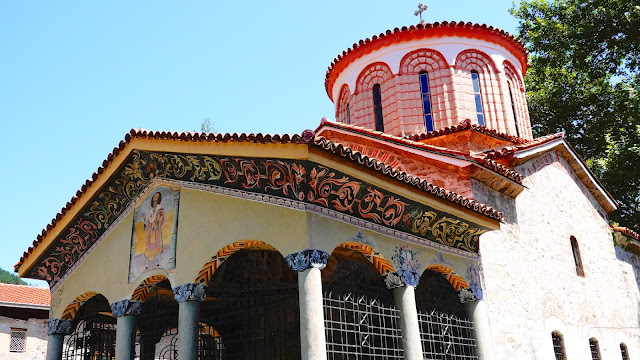This post sees us drive from Koprivshtitsa to Plovdiv in Bulgaria via Strelcha (town), Lake Yazovir Pyasachnik Dam, Bachkovo Monastery and the Asens Fortress. We visit the very historic and colourful Old Town of Plovdiv.
The first 50km out of Koprivshtitsa saw us descent down into a lush green valley that then presented the Lake Yazovir Pyasachnik and we took photos of the lake from the dam wall. We could see people camping on its shores and some fishing taking place further in.
The Bachkovo Monastery is the second most important monastery after Rila Monastery having been founded in 1083 by Prince Gregory Pakourianos, a prominent statesman and military commander in the Byzantine service, as a Georgian-dominated Orthodox monastery. He set up a seminary for the youth at the monastery. The curriculum included religion, as well as mathematics, history and music. In the 13th century, the Georgian and Chalcedonic Armenian monks of the Petritsioni (Bachkovo) Monastery lost their domination over the monastery, but their traditions were preserved until the beginning of 14th century and an Armenian Gospel from the 10th century that came from this monastery still exists today. The Cathedral Church of the Virgin Mary (dating from 1604) is the place where a valuable icon of the Virgin Mary Eleusa from 1310 is kept (brought from Georgia). According to the legend, the icon is wonder-working, attracting many pilgrims. This church was built in the place of the monastery's oldest church destroyed by the Turks.
Asen's Fortress is a medieval fortress just outside the town of Asenovgrad. It was built in the 9th Century by the Byzantine Emperor to protect the area from incursions by invaders from the Aegean in Greece. The best-preserved and most notable feature of Asen's Fortress is the Church of the Holy Mother of God from the 12th-13th century.
Plovdiv (Pop 348,000, Elev 166m, Second Largest City in Bulgaria) is THE OLDEST CONTINUOUSLY INHABITED CITY IN EUROPE and one of the oldest cities in the world dating back to 6000BC !!!
The city was subsequently a local Thracian settlement, later being conquered and ruled also by Persians, Ancient Macedonians, Celts, Romans, Byzantines, Goths, Huns, Bulgarians (Thracians, Bulgars, Slavic tribes, etc.), Crusaders, and Ottoman Turks. It is literally a city of all Eastern European Cultures.
Plovdiv is situated in a large open basin surrounded by distant mountains just like Sofia. Both cities benefit greatly from this type of geography in that they are surrounded buy agricultural produce that is cheap to delver to the many mouths that need it. he city has historically developed on seven syenite hills, some of which are 250 metres (820 feet) high. Because of these hills, Plovdiv is often referred to in Bulgaria as "The City of the Seven Hills".
Plovdiv was first known ad Philippopolis, an ancient city that was founded by the father of Alexander the Great, Philip the Great (359–336 BC), the king of ancient Macedonia, settling there both Thracians and 2,000 Macedonians and Greeks in 342 BC.
The Old Town is a living museum with traces of almost all former European civilisations – it is like a big outdoor museum !!! I say this because there are Roman ruins literally under your feet like Sofia only more extensive and better-preserved including two amphitheatres. The main pedestrian mall is lined with multi-coloured classical buildings and the Old Town is a cobble stone paradise of colourful wooden Tudor-style buildings culminating in the archaeological site of Nebet Tepe which was first inhabited in 6000BC but is now abandoned and covered in graffiti in places – this is the most disappointing aspect of this city full of potential.
Enjoy the surprising Plovdiv...






































No comments:
Post a Comment